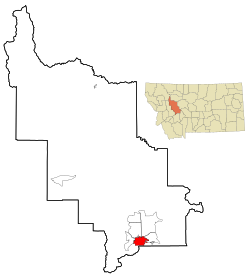HELENA,MONTANA
| Helena, Montana | |||
|---|---|---|---|
| — City — | |||
| |||
| Nickname(s): Queen City of the Rockies, The Capital City | |||
| Location in Lewis and Clark County, Montana | |||
| Coordinates: 46°35′44.9″N 112°1′37.31″W / 46.595806°N 112.0270306°W | |||
| Country | United States | ||
| State | Montana | ||
| County | Lewis and Clark | ||
| Founded | October 30, 1864 | ||
| Government | |||
| - Mayor | James E. Smith | ||
| Area | |||
| - City | 14.0 sq mi (36.3 km2) | ||
| - Land | 14.0 sq mi (36.3 km2) | ||
| - Water | 0 sq mi (0 km2) | ||
| Elevation | 3,875 (Helena Regional Airport) ft (1,237 m) | ||
| Population (2010) | |||
| - City | 28,190 | ||
| - Density | 2,138.5/sq mi (710.5/km2) | ||
| - Metro | 74,801 | ||
| Time zone | Mountain (UTC-7) | ||
| - Summer (DST) | Mountain (UTC-6) | ||
| Area code(s) | 406 | ||
| FIPS code | 30-35600 | ||
| GNIS feature ID | 0802116 | ||
| Website | www.ci.helena.mt.us | ||
Helena is the principal city of the Helena Micropolitan Statistical Area, which includes all of Lewis and Clark and Jefferson counties; its population is 74,801 on July 1, 2009.[3]
History
Helena was founded with the July 14, 1864 discovery of gold in a gulch off the Prickly Pear valley by the "Four Georgians". The city's main street is named Last Chance Gulch and lies close to the winding path of the original gulch through the historic downtown district.The original camp was named "Last Chance" by the Four Georgians. By fall, the population had grown to over 200 and the name "Last Chance" was viewed as too crass. On October 30, 1864, a group of at least seven men met to name the town, authorize the layout of the streets, and elect commissioners. The first suggestion was "Tomah," a word the committee thought had connections to the local Indian people of the area. Other nominations included Pumpkinville and Squashtown (as the meeting was held the day before Halloween). Other suggestions were to name the community after various Minnesota towns, such as Winona and Rochester. Finally, a Scotsman named John Summerville proposed "Helena," which he pronounced "hel-EE-na," "in honor of the heLEENa in Scott County, Minnesota..." This immediately caused an uproar from the former Confederates in the room who insisted upon the pronunciation HELena, after Helena, Arkansas, a town on the Mississippi River. While the name won, the pronunciation varied until approximately 1882 when the HELena pronunciation became dominant and has remained so to the present. Later tales of the naming of Helena claimed the name came variously from the island of St. Helena, where Napoleon had been exiled, or was that of a miner's sweetheart.[4]
The townsite was first surveyed in 1865 by Captain John Wood. However, many of the original streets followed the chaotic paths of the miners, going around claims and following the winding gulch. As a result, few city blocks are consistent in size, rather they have an irregular variety of shapes and sizes.
In 1870, Henry D. Washburn, having been appointed Surveyor General of Montana in 1869, organized the Washburn-Langford-Doane Expedition in Helena to explore the regions that would become Yellowstone National Park. Mount Washburn, located within the park, is named for him. Members of the expedition included Helena residents: Truman C. Everts - former U.S. Assessor for the Montana Territory, Judge Cornelius Hedges - U.S. Attorney, Montana Territory, Samuel T. Hauser - President of the First National Bank, Helena, Montana; later a Governor of the Montana Territory, Warren C. Gillette - Helena merchant, Benjamin C. Stickney Jr. - Helena merchant, Walter Trumbull - son of U.S. Senator Lyman Trumbull (Illinois) and Nathaniel P. Langford, then former U.S. Collector of Internal Revenue for Montana Territory. Langford helped Washburn organize the expedition and later helped publicize the remarkable Yellowstone region. In May 1872 after the park's creation, Langford was named its first superintendent.

The St. Helena Cathedral as seen from Mount Helena.
The official symbol of Helena is a drawing of "The Guardian of the Gulch", a wooden fire watch tower built in 1886, that still stands on "Tower Hill" overlooking the historic downtown district. This fire tower replaced a series of observation buildings, the original being a flimsy lookout stand built in 1870 on the same site, built in response to a series of devastating fires: April 1869, November 1869, October 1871, August 1872 and January 1874 that swept through the early mining camp.
In 1889, railroad magnate Charles Arthur Broadwater opened his fabled Hotel Broadwater and Natatorium west of Helena. The Natatorium was home to the world's first indoor swimming pool. Damaged in the earthquake of 1935, it was closed in 1941. The many buildings on the property were demolished in 1976. Today, the Broadwater Fitness Center stands just west of the Hotel & Natatorium's original location, complete with an outdoor pool heated by natural spring water running underneath it.
In 1902, the Montana State Capitol was completed. Helena has been the capital of Montana Territory since 1875 and the state of Montana since 1889. A large portion of the conflict between Marcus Daly and William Andrews Clark (the Copper Kings) was over the location of the state capital. Until the 1900 census, Helena was the most populated city in the state.
The Civic Center and the Saint Helena Cathedral[1] are two of many unique historic buildings in Helena.
Helena High School and Capital High School are both public high schools located in the Helena School District No. 1. Being the state capital, a large number of Helenans work for the state government. When in Helena, most people visit the local walking mall, completed in the early 1980s after Urban Renewal and the Model Cities Program in the early 1970s had removed many historic buildings from the downtown district, taking nearly a decade to renovate, a three block long shopping district following the original Last Chance Gulch. There is a small artificial stream running along most of the walking mall, mirroring the underground springs that originally flowed above ground in parts of the Gulch.
The Archie Bray Foundation, an internationally-renowned ceramics center founded in 1952, is located just northwest of Helena, near Spring Meadow Lake.
Helena also has a local ski area, Great Divide Ski Area, northwest of town near the ghost town of Marysville.
Geography and climate
Helena is located at 46°35′45″N 112°1′37″W / 46.59583°N 112.02694°W (46.595805, -112.027031),[5] at an altitude of 4,058 feet (1,237 m).[6]Surrounding features include the Continental Divide, Mount Helena City Park, Spring Meadow Lake State Park, Lake Helena, Helena National Forest, the Big Belt Mountains, the Gates of the Mountains Wilderness, Sleeping Giant Wilderness Study Area, Bob Marshall Wilderness, Scapegoat Wilderness, the Missouri River, Canyon Ferry Lake, Holter Lake, Hauser Lake, and the Elkhorn Mountains.
According to the United States Census Bureau, the city has a total area of 14.0 square miles (36 km2), all of it land.
Helena has a semi-arid climate (Köppen BSk), with long, cold and moderately snowy winters, hot and dry summers, and short springs and autumns in between. Monthly daily means range from 20.2 °F (−6.6 °C) in January to 67.9 °F (19.9 °C) in July, with lows significantly cooler from April to October, due to the aridity and elevation. Snowfall has been observed in every month of the year, [7] but is usually absent from May to September, and normally accumulates in only light amounts. Winters have periods of moderation, partly due to warming influence from chinooks. Precipitation mostly falls in the spring and is generally sparse, averaging only 11.3 inches (287 mm) annually.
Subzero (below −18 °C) cold is observed 23 nights per year, but is rarely extended, as is 90 °F (32 °C) heat, which occurs on 19 days annually.[7] Extremes range from −42 to 105 °F (-41 to 41 °C), occurring as recently as February 2, 1996 and July 12, 2002, respectively.
| [hide]Climate data for Helena, Montana | |||||||||||||
|---|---|---|---|---|---|---|---|---|---|---|---|---|---|
| Month | Jan | Feb | Mar | Apr | May | Jun | Jul | Aug | Sep | Oct | Nov | Dec | Year |
| Record high °F (°C) | 63 (17.2) | 69 (20.6) | 78 (25.6) | 86 (30) | 95 (35) | 102 (38.9) | 105 (40.6) | 105 (40.6) | 99 (37.2) | 87 (30.6) | 75 (23.9) | 64 (17.8) | 105 (40.6) |
| Average high °F (°C) | 30.5 (-0.83) | 37.3 (2.94) | 46.8 (8.22) | 56.9 (13.83) | 65.9 (18.83) | 75.0 (23.89) | 83.4 (28.56) | 82.5 (28.06) | 71.0 (21.67) | 58.4 (14.67) | 41.5 (5.28) | 31.5 (-0.28) | 56.7 (13.72) |
| Daily mean °F (°C) | 20.2 (-6.56) | 26.4 (-3.11) | 35.1 (1.72) | 44.1 (6.72) | 52.9 (11.61) | 61.2 (16.22) | 67.8 (19.89) | 66.7 (19.28) | 56.1 (13.39) | 44.8 (7.11) | 30.9 (-0.61) | 21.4 (-5.89) | 44.0 (6.67) |
| Average low °F (°C) | 9.9 (-12.28) | 15.6 (-9.11) | 23.5 (-4.72) | 31.2 (-0.44) | 39.8 (4.33) | 47.5 (8.61) | 52.3 (11.28) | 50.8 (10.44) | 41.2 (5.11) | 31.2 (-0.44) | 20.3 (-6.5) | 11.3 (-11.5) | 31.2 (-0.44) |
| Record low °F (°C) | −42 (-41.1) | −42 (-41.1) | −30 (-34.4) | −10 (-23.3) | 17 (-8.3) | 30 (-1.1) | 36 (2.2) | 28 (-2.2) | 6 (-14.4) | −8 (-22.2) | −39 (-39.4) | −40 (-40) | −42 (-41.1) |
| Precipitation inches (mm) | 0.52 (13.2) | 0.38 (9.7) | 0.63 (16) | 0.91 (23.1) | 1.78 (45.2) | 1.82 (46.2) | 1.34 (34) | 1.29 (32.8) | 1.05 (26.7) | 0.66 (16.8) | 0.48 (12.2) | 0.46 (11.7) | 11.32 (287.5) |
| Snowfall inches (cm) | 8.4 (21.3) | 5.3 (13.5) | 6.8 (17.3) | 4.6 (11.7) | .9 (2.3) | 0 (0) | 0 (0) | .3 (0.8) | 1.2 (3) | 3.0 (7.6) | 5.4 (13.7) | 7.7 (19.6) | 43.6 (110.7) |
| Avg. precipitation days (≥ 0.01 in) | 7.5 | 6.3 | 8.1 | 8.6 | 11.4 | 10.4 | 8.1 | 7.7 | 6.3 | 5.7 | 6.7 | 7.3 | 94.1 |
| Avg. snowy days (≥ 0.1 in) | 6.9 | 5.6 | 5.6 | 3.8 | .7 | 0 | 0 | .1 | .7 | 2.0 | 5.0 | 7.0 | 37.4 |
| Sunshine hours | 120.9 | 149.7 | 226.3 | 243.0 | 282.1 | 309.0 | 368.9 | 325.5 | 255.0 | 201.5 | 120.0 | 99.2 | 2,701.1 |










0 komentar:
Posting Komentar